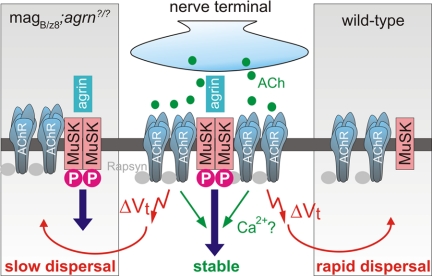Fig. 5.
Proposed model for the action of acetylcholine to stabilize AChR clusters. At the NMJ, release of agrin causes MuSK dimerization and phosphorylation. This activates intracellular signaling pathways. Release of ACh from the presynaptic nerve terminal depolarizes the muscle fiber (ΔVt) and disperses aneural AChR clusters (red arrow). ACh also causes the opening of AChRs and stabilizes them at sites of agrin-MuSK signaling. Dispersal of aneural AChR clusters in wild-type mice, which are not stabilized by agrin-MuSK signaling is fast (right part of the scheme). In magB/z8 transgenic mice, aneural AChR clusters are stabilized by agrin-MuSK signaling (left part of the scheme) but most of them still disperse slowly as they lack the local ACh signal from the nerve terminal. One possibility for the stabilizing function of ACh on postsynaptic structures is the local influx of Ca2+ via AChRs that could act in parallel with agrin-MuSK signaling.

